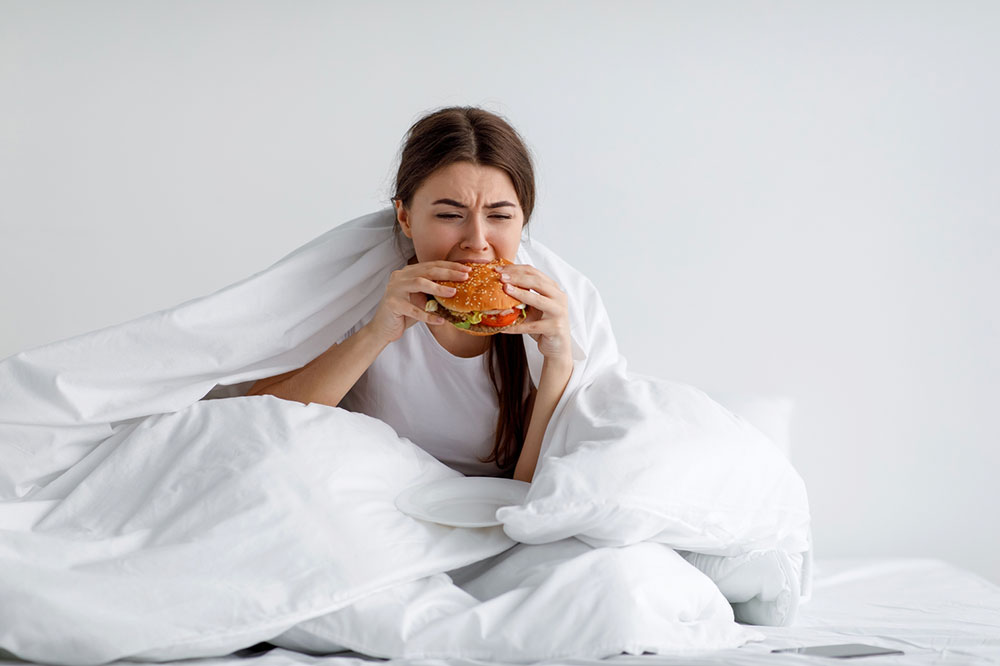15 bad habits that make mattresses dirty

The significance of a clean and hygienic mattress cannot be overstated. Beyond comfort lies a vital connection between mattress cleanliness and personal well-being. A dirty mattress not only compromises the quality of one’s sleep but can also pose potential health risks. This makes it imperative to understand the importance of a clean mattress. By doing so, individuals can enhance the quality of their sleep. Here are some practices that compromise mattress quality:
1. Skipping regular cleaning
Regular cleaning is a key factor in preserving mattress hygiene. Over time, mattresses accumulate dust mites, dead skin cells, and other allergens that can affect sleep quality and respiratory health. By neglecting to vacuum the mattress every few months, individuals allow these unwanted guests to increase, potentially leading to discomfort and allergies.
2. Eating in bed
The allure of a cozy breakfast or a late-night snack in bed is undeniable, but it comes at a cost. Crumbs, spills, and food particles can easily find their way into the mattress, providing a feast for dust mites and other unwelcome microorganisms. Apart from affecting mattress cleanliness, this habit can also lead to unpleasant odors and the formation of stains, compromising the overall sleep experience.
3. Ignoring stains
Spills and stains are inevitable, but ignoring them can lead to more significant issues. Stains should be addressed promptly, whether it’s a coffee mishap or a bedtime snack gone wrong. Failing to do so not only jeopardizes the esthetic appeal of the mattress but can also create an environment conducive to the growth of mold and bacteria, potentially impacting health.
4. Failing to use a mattress protector
A mattress protector is like a shield against spills, stains, and allergens. However, not using one is a common oversight. Investing in a quality mattress protector is a simple yet effective way to extend the life of the mattress and keep it in better condition. It acts as a barrier, preventing liquids and particles from penetrating the mattress and making cleaning more manageable.
5. Allowing pets on the bed
Pets are cherished family members, but their presence on the bed can introduce dirt, hair, and allergens. Regular grooming of pets and using pet-friendly bedding can help minimize the impact of furry friends on mattress cleanliness. Additionally, a washable pet bed or blanket can provide a designated space for pets, reducing the transfer of dirt and allergens.
6. Forgetting to wash bedding regularly
Clean sheets contribute significantly to a clean mattress. Failing to wash sheets and pillowcases regularly allows sweat, body oils, and other contaminants to seep into the mattress. Establishing a routine of washing bedding every one to two weeks is a simple yet effective habit for maintaining a cleaner sleep environment. It promotes personal hygiene and enhances the overall freshness of the sleeping space.
7. Neglecting to rotate and flip the mattress
Rotating and flipping the mattress is more than just a suggestion—it’s a crucial practice for maintaining mattresses. Doing so distributes wear and tear evenly, preventing sagging and indentations. Neglecting this habit can lead to uneven surfaces and compromise the overall support and comfort provided by the mattress. Many mattresses are designed to be rotated and flipped, so adhering to the manufacturer’s guidelines is advisable.
8. Failing to air out the mattress
Proper ventilation is essential for mattress hygiene. Mattresses need to breathe to prevent the growth of mold and mildew. Keeping the bedroom well-ventilated by opening windows, using a fan, or investing in a breathable mattress can contribute to a fresher sleeping environment. Adequate ventilation not only helps maintain cleanliness but also extends the longevity of the mattress.
9. Sleeping with wet hair
Sleeping with wet hair, especially if it’s a frequent habit, can introduce moisture into the mattress. This moisture creates an ideal environment for mold and mildew to thrive, leading to potential health issues. Towel-drying hair thoroughly before bedtime is a simple yet effective practice to maintain mattress cleanliness.
10. Not using a mattress topper
A mattress topper can serve as an additional layer of protection, preventing sweat, spills, and dead skin cells from directly reaching the mattress. Not utilizing a mattress topper exposes the mattress to wear and tear, shortening its lifespan and compromising hygiene.
11. Overlooking bed bugs and dust mites
Neglecting to address bed bugs and dust mites promptly can result in a dirty and unhealthy mattress. Regularly inspecting and cleaning the mattress for signs of infestation, such as tiny blood spots or small black dots, is essential. Taking preventive measures, such as using bed bug-resistant encasements, can contribute to maintaining a cleaner sleep environment.
12. Allowing shoes on the bed
Walking on the mattress with shoes not only brings in dirt from the outside but can also introduce potentially harmful bacteria. Encouraging a no-shoes-on-the-bed policy helps keep the mattress cleaner and prevents the accumulation of outdoor pollutants.
13. Overusing fabric fresheners
While using fabric fresheners can help maintain a pleasant scent, overusing them can lead to the buildup of chemicals on the mattress. This buildup may cause skin irritation and respiratory issues. Using such products in moderation and choosing natural or hypoallergenic options is essential.
14. Overcrowding the bed with decorative pillows
Decorative pillows may add a touch of style, but too many can contribute to a dirtier mattress. They collect dust, hair, and allergens, which transfer to the mattress over time. Streamlining the number of decorative pillows and regularly washing them can mitigate this issue.
15. Failing to clean the bedroom regularly
A dirty bedroom environment can impact the cleanliness of the mattress. Dusting, vacuuming, and regularly cleaning the bedroom prevent dust and allergen accumulation, indirectly preserving the mattress’s cleanliness.